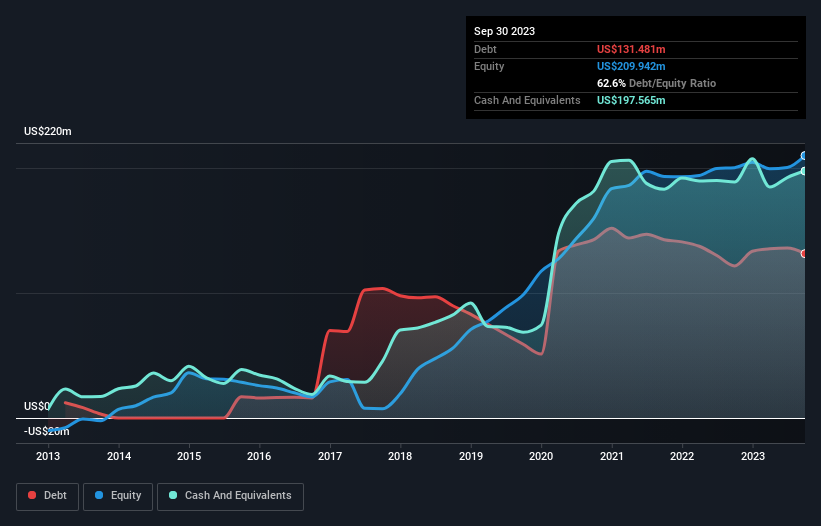- Netherlands
- /
- Biotech
- /
- ENXTAM:PHARM
Health Check: How Prudently Does Pharming Group (AMS:PHARM) Use Debt?

Some say volatility, rather than debt, is the best way to think about risk as an investor, but Warren Buffett famously said that 'Volatility is far from synonymous with risk.' When we think about how risky a company is, we always like to look at its use of debt, since debt overload can lead to ruin. As with many other companies Pharming Group N.V. (AMS:PHARM) makes use of debt. But the more important question is: how much risk is that debt creating?
When Is Debt Dangerous?
Debt is a tool to help businesses grow, but if a business is incapable of paying off its lenders, then it exists at their mercy. If things get really bad, the lenders can take control of the business. However, a more frequent (but still costly) occurrence is where a company must issue shares at bargain-basement prices, permanently diluting shareholders, just to shore up its balance sheet. Of course, plenty of companies use debt to fund growth, without any negative consequences. When we think about a company's use of debt, we first look at cash and debt together.
See our latest analysis for Pharming Group
What Is Pharming Group's Debt?
You can click the graphic below for the historical numbers, but it shows that as of September 2023 Pharming Group had US$131.5m of debt, an increase on US$121.6m, over one year. However, it does have US$197.6m in cash offsetting this, leading to net cash of US$66.1m.

How Healthy Is Pharming Group's Balance Sheet?
The latest balance sheet data shows that Pharming Group had liabilities of US$68.1m due within a year, and liabilities of US$158.5m falling due after that. Offsetting this, it had US$197.6m in cash and US$40.5m in receivables that were due within 12 months. So it actually has US$11.6m more liquid assets than total liabilities.
This state of affairs indicates that Pharming Group's balance sheet looks quite solid, as its total liabilities are just about equal to its liquid assets. So while it's hard to imagine that the US$757.9m company is struggling for cash, we still think it's worth monitoring its balance sheet. Succinctly put, Pharming Group boasts net cash, so it's fair to say it does not have a heavy debt load! There's no doubt that we learn most about debt from the balance sheet. But ultimately the future profitability of the business will decide if Pharming Group can strengthen its balance sheet over time. So if you want to see what the professionals think, you might find this free report on analyst profit forecasts to be interesting.
In the last year Pharming Group wasn't profitable at an EBIT level, but managed to grow its revenue by 7.3%, to US$219m. We usually like to see faster growth from unprofitable companies, but each to their own.
So How Risky Is Pharming Group?
Statistically speaking companies that lose money are riskier than those that make money. And we do note that Pharming Group had an earnings before interest and tax (EBIT) loss, over the last year. And over the same period it saw negative free cash outflow of US$4.0m and booked a US$22m accounting loss. Given it only has net cash of US$66.1m, the company may need to raise more capital if it doesn't reach break-even soon. Even though its balance sheet seems sufficiently liquid, debt always makes us a little nervous if a company doesn't produce free cash flow regularly. There's no doubt that we learn most about debt from the balance sheet. However, not all investment risk resides within the balance sheet - far from it. Case in point: We've spotted 1 warning sign for Pharming Group you should be aware of.
When all is said and done, sometimes its easier to focus on companies that don't even need debt. Readers can access a list of growth stocks with zero net debt 100% free, right now.
New: Manage All Your Stock Portfolios in One Place
We've created the ultimate portfolio companion for stock investors, and it's free.
• Connect an unlimited number of Portfolios and see your total in one currency
• Be alerted to new Warning Signs or Risks via email or mobile
• Track the Fair Value of your stocks
Have feedback on this article? Concerned about the content? Get in touch with us directly. Alternatively, email editorial-team (at) simplywallst.com.
This article by Simply Wall St is general in nature. We provide commentary based on historical data and analyst forecasts only using an unbiased methodology and our articles are not intended to be financial advice. It does not constitute a recommendation to buy or sell any stock, and does not take account of your objectives, or your financial situation. We aim to bring you long-term focused analysis driven by fundamental data. Note that our analysis may not factor in the latest price-sensitive company announcements or qualitative material. Simply Wall St has no position in any stocks mentioned.
About ENXTAM:PHARM
Pharming Group
A biopharmaceutical company, develops and commercializes protein replacement therapies and precision medicines for the treatment of rare diseases in the United States, Europe, and internationally.
Undervalued with excellent balance sheet.
Similar Companies
Market Insights
Community Narratives



